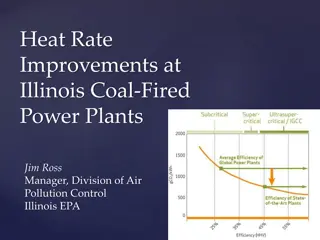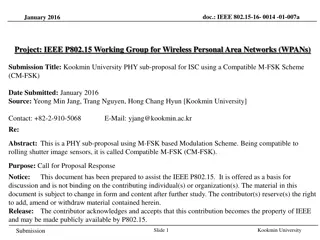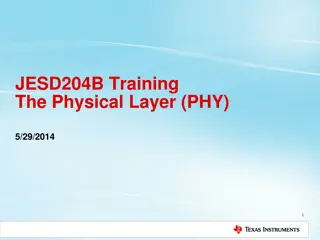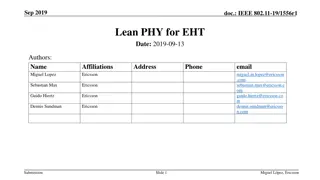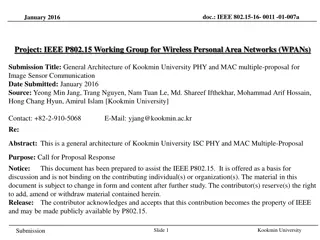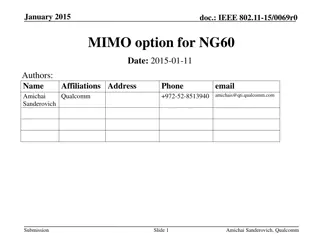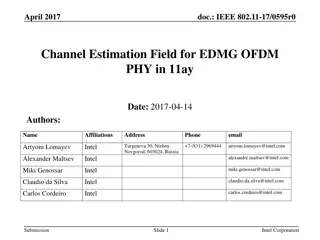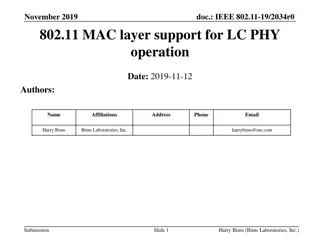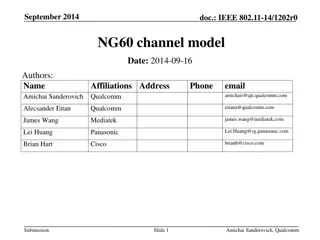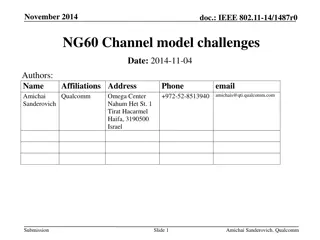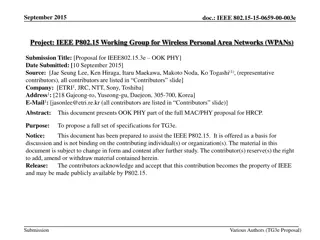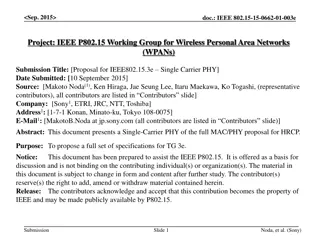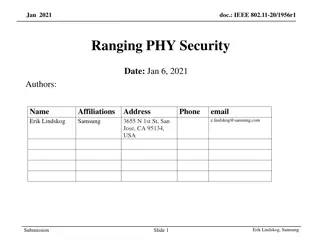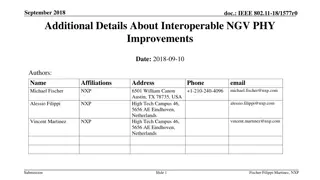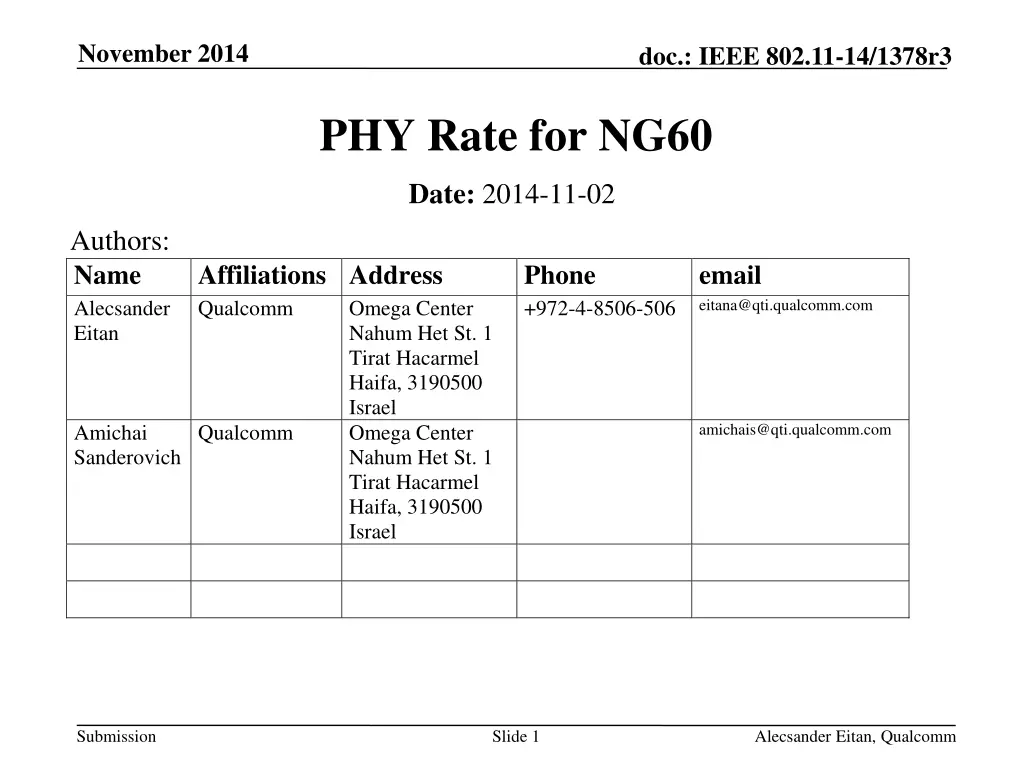
IEEE 802.11-14/1378r3: NG60 PHY Rate and Channel Bonding Analysis
Explore the November 2014 documentation on IEEE 802.11-14/1378r3, focusing on parameters affecting PHY rate, channel bonding, MIMO configurations, and more in the context of NG60 technology. Detailed insights are provided by Alecsander Eitan from Qualcomm with valuable information on spectral allocation, channel spacing, FFT sizing, data carriers, modulation, and potential MIMO capacity gains.
Download Presentation

Please find below an Image/Link to download the presentation.
The content on the website is provided AS IS for your information and personal use only. It may not be sold, licensed, or shared on other websites without obtaining consent from the author. If you encounter any issues during the download, it is possible that the publisher has removed the file from their server.
You are allowed to download the files provided on this website for personal or commercial use, subject to the condition that they are used lawfully. All files are the property of their respective owners.
The content on the website is provided AS IS for your information and personal use only. It may not be sold, licensed, or shared on other websites without obtaining consent from the author.
E N D
Presentation Transcript
November 2014 doc.: IEEE 802.11-14/1378r3 PHY Rate for NG60 Date: 2014-11-02 Authors: Name Alecsander Eitan Affiliations Address Qualcomm Phone +972-4-8506-506 email eitana@qti.qualcomm.com Omega Center Nahum Het St. 1 Tirat Hacarmel Haifa, 3190500 Israel Omega Center Nahum Het St. 1 Tirat Hacarmel Haifa, 3190500 Israel amichais@qti.qualcomm.com Amichai Sanderovich Qualcomm Submission Slide 1 Alecsander Eitan, Qualcomm
November 2014 doc.: IEEE 802.11-14/1378r3 Parameters that affect PHY Rate Channel Bonding Contiguous Fill gaps MIMO Constellation Symbol length and Guard-Interval Coding Rate Modulation Submission Slide 2 Alecsander Eitan, Qualcomm
November 2014 doc.: IEEE 802.11-14/1378r3 Channel Bonding The 60G spectrum allocation specifies up to 4 channels Submission Slide 3 Alecsander Eitan, Qualcomm
November 2014 doc.: IEEE 802.11-14/1378r3 Channel Bonding 20 10 0 -10 Mask [dB] -20 -30 -40 -50 -6 -4 -2 0 2 4 6 8 Frequency [GHz] relative to channel 2 Submission Slide 4 Alecsander Eitan, Qualcomm
November 2014 doc.: IEEE 802.11-14/1378r3 Channel Bonding Simple channel bonding analysis can assume simple multiplication by number of channels. In channel bonding gaps between channels can be used. For simplicity, the analysis will be done for OFDM modulation: In 802.11ad the following parameters are used FFT size 512 Data carriers 336 CP is 25% Sampling rate is 2.64Gsps Hence: bin width (carrier) is: 2.64G/512 = 5.1563 MHz Number of used bins (carriers) is: 355 Channel spacing is 2.16GHz, which are ~419 carriers. Submission Slide 5 Alecsander Eitan, Qualcomm
November 2014 doc.: IEEE 802.11-14/1378r3 Channel Bond In 802.11ad there are 355 bins in a 419 bins spaced channels Using simple extrapolation for same bin width: Case 2ch 3ch 4ch Equation (355+419)*336/355 (355+2*419)*336/355 (355+3*419)*336/355 Data bins 732 1129 1525 factor 2.18 3.36 4.54 The actual design may change the exact values to simplify the implementation. Submission Slide 6 Alecsander Eitan, Qualcomm
November 2014 doc.: IEEE 802.11-14/1378r3 MIMO Various MIMO configurations can be considered: 2x2 2x4 3x3 4x4 And more The MIMO capacity gain is bounded by RF chains in each end and by the channel. Max capacity gain for a 4x4 setup is: 4 #1 #1 #2 #2 #3 #3 #4 #4 Submission Slide 7 Alecsander Eitan, Qualcomm
November 2014 doc.: IEEE 802.11-14/1378r3 Constellation 802.11ad already supports QAM: 16QAM and 64QAM We suggest to consider also modulations of 128QAM and 256QAM Optimization may lead to APSK instead of QAM, but this will not affect capacity nor following analysis Submission Slide 8 Alecsander Eitan, Qualcomm
November 2014 doc.: IEEE 802.11-14/1378r3 Symbol Length and Guard Interval 802.11ad supports: OFDM: sample rate = 2.64Gsps, FFT size = 512, CP = 25% SC: sample rate = 1.76Gsps, symbol length = 512 (incl. GI), GI length = 64 For the purpose of this analysis we suggest to keep the symbol duration and GI the same (SC: GI length and GI spacing in time). One may suggest some optimizations. Impact will be relatively small. For very short links, that will be able to utilize high QAM, one may argue that the GI can be shorten, and/or symbols can be longer. Such modification will lead to improved efficiency. However the benefit is bounded by ~15%. Submission Slide 9 Alecsander Eitan, Qualcomm
November 2014 doc.: IEEE 802.11-14/1378r3 Coding rate 802.11ad supports the following rates: 1/2, 5/8, 3/4, and 13/16. At this time we assume no change. One may argue that for 256QAM 7/8 is better. However the difference is only about 6%. Submission Slide 10 Alecsander Eitan, Qualcomm
November 2014 doc.: IEEE 802.11-14/1378r3 Modulation 802.11ad supports: SC and OFDM At this time we assume that same rate can be achieved in both modes. This is a fair assumption, although optimization may shift the number slightly. Submission Slide 11 Alecsander Eitan, Qualcomm
November 2014 doc.: IEEE 802.11-14/1378r3 SC Modulation SC channel bonding extension results in rate gain of 2, 3 or 4, proportional to the number of channels. Assuming same mask edges and roll-off factor. 0 0 Mask Modulated signal -5 -5 -10 -10 Mask [dB] Mask [dB] -15 -15 -20 -20 -25 -25 Mask Modulated signal -30 -30 -6 -4 -2 0 2 4 6 -6 -4 -2 0 2 4 6 Frequency [GHz] - relative to channel center Frequency [GHz] - relative to channel center Submission Slide 12 Alecsander Eitan, Qualcomm
November 2014 doc.: IEEE 802.11-14/1378r3 PHY Rate Summary - 1 Combining the major factor and using the maximum achievable improvements: MIMO \ Channels: 1x1 2x2 3x3 4x4 1 2 3 4 9.70 19.40 29.11 38.81 21.15 42.30 63.45 84.60 32.60 65.20 97.80 130.39 44.05 88.09 132.14 176.19 Assumptions: 256QAM Code rate: 7/8 Additional improvement: 0% Conclusion: 100Gbps is an achievable PHY rate Submission Slide 13 Alecsander Eitan, Qualcomm
November 2014 doc.: IEEE 802.11-14/1378r3 PHY Rate Summary - 2 Combining the major factor and using a very conservative approach: MIMO \ Channels: 1x1 2x2 3x3 4x4 1 2 3 4 6.24 12.47 18.71 24.95 13.60 27.19 40.79 54.39 20.96 41.91 62.87 83.83 28.32 56.63 84.95 113.26 Assumptions: 64QAM Code rate: 3/4 Additional improvement: 0% Conclusion: 40Gbps is an achievable PHY rate (MIMO 2x2 and bonding of 3) Submission Slide 14 Alecsander Eitan, Qualcomm
November 2014 doc.: IEEE 802.11-14/1378r3 PHY Rate Summary - 3 Combining the major factor and using a moderate approach: MIMO \ Channels: 1x1 2x2 3x3 4x4 1 2 3 4 7.88 15.77 23.65 31.53 17.18 34.37 51.55 68.74 26.49 52.97 79.46 105.95 35.79 71.58 107.36 143.15 Assumptions: 128QAM Code rate: 13/16 Additional improvement: 0% Conclusion: 100Gbps is achievable PHY rate Submission Slide 15 Alecsander Eitan, Qualcomm
November 2014 doc.: IEEE 802.11-14/1378r3 Summary It was shown that using the existing ideas for increasing the PHY rate, 100Gbps is an achievable goal. Reaching 40Gbps looks feasible even with MIMO of 2x2, three channels bonding, 64QAM and current LDPC code. This fits into mobile small FF as well. For the PAR and CSD we suggest to use 20Gbps (MAC rate) This analysis was done by using existing parameters, without performing a detailed design of the proposed PHY. Submission Slide 16 Alecsander Eitan, Qualcomm


